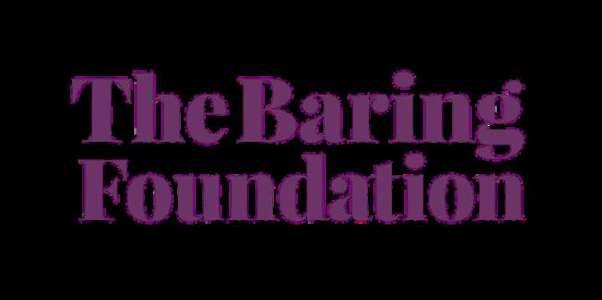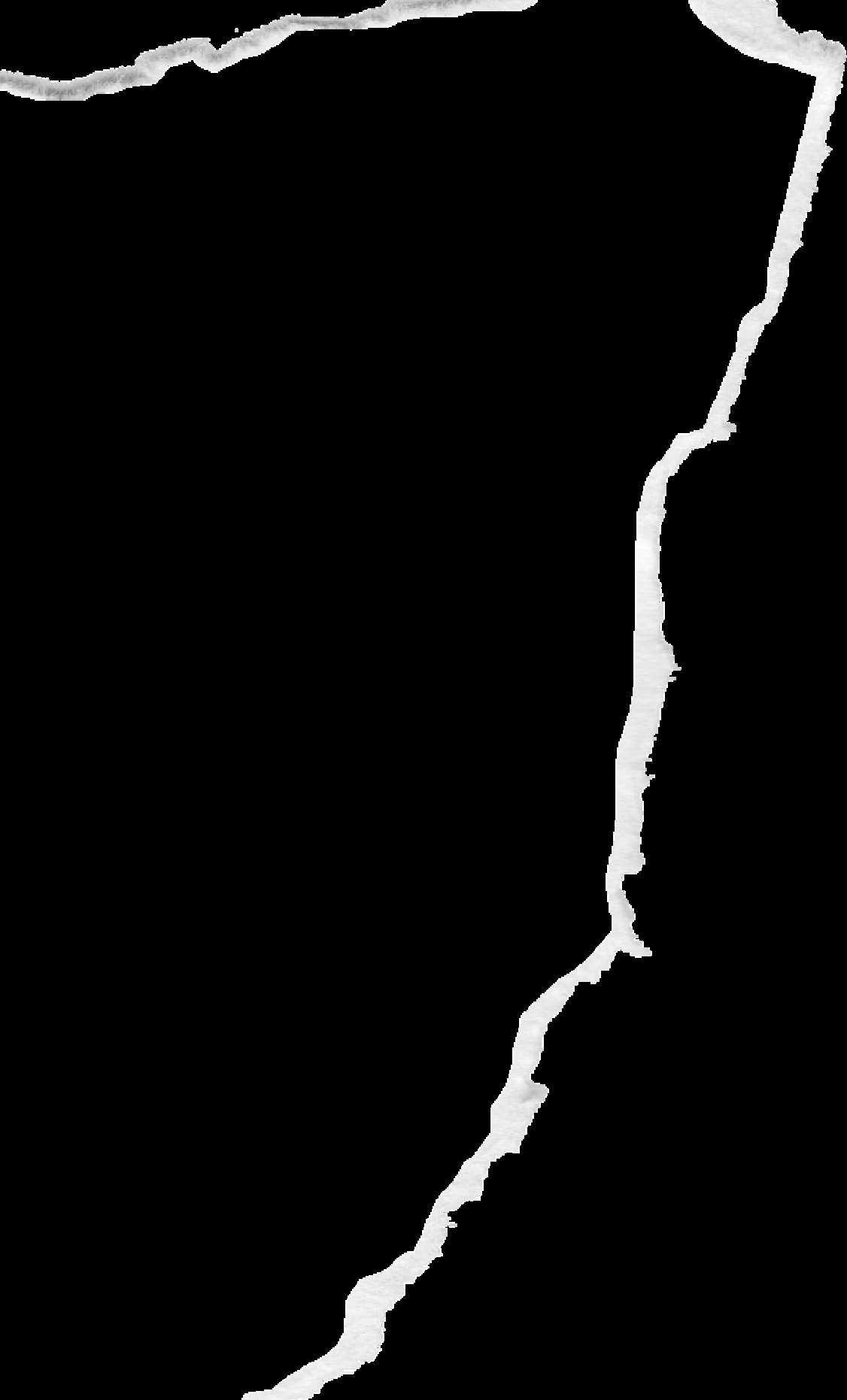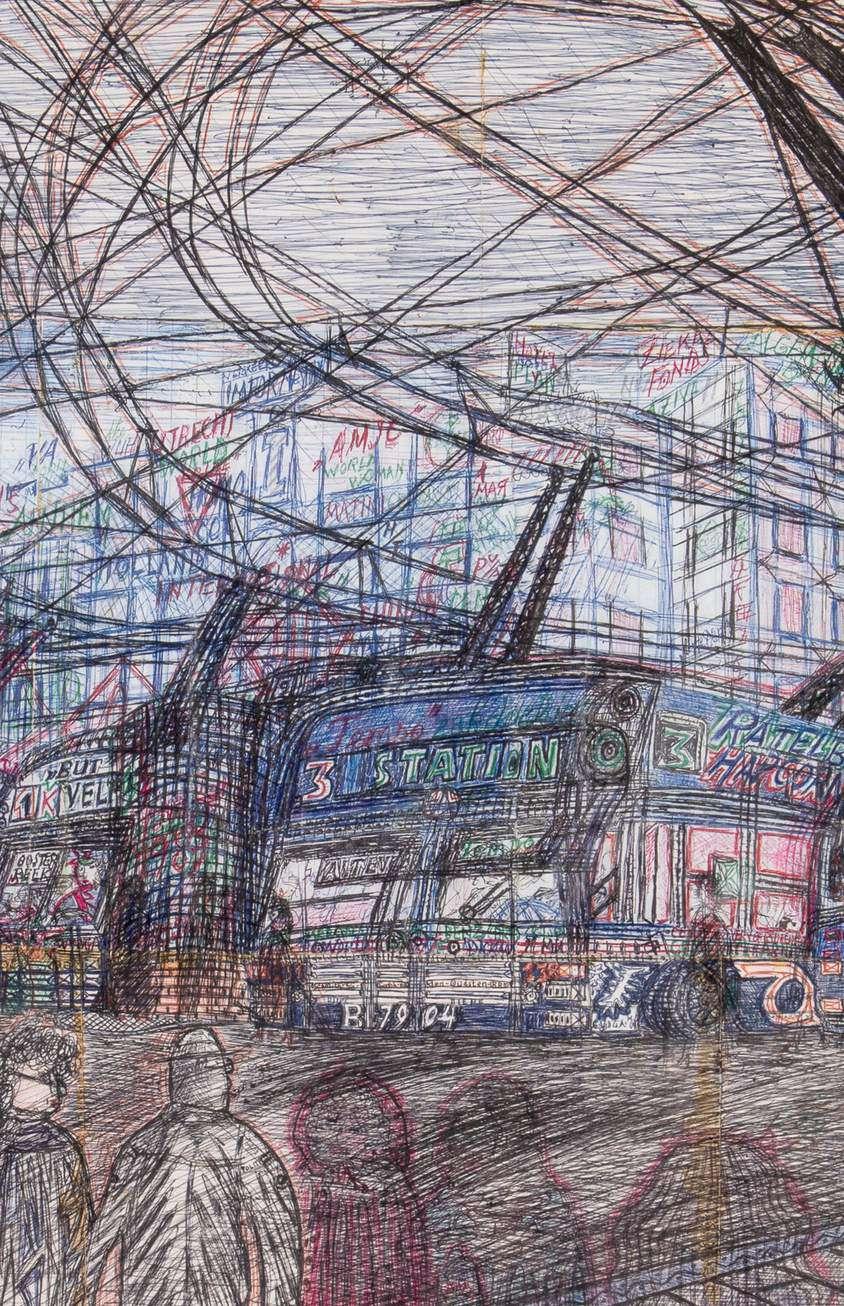






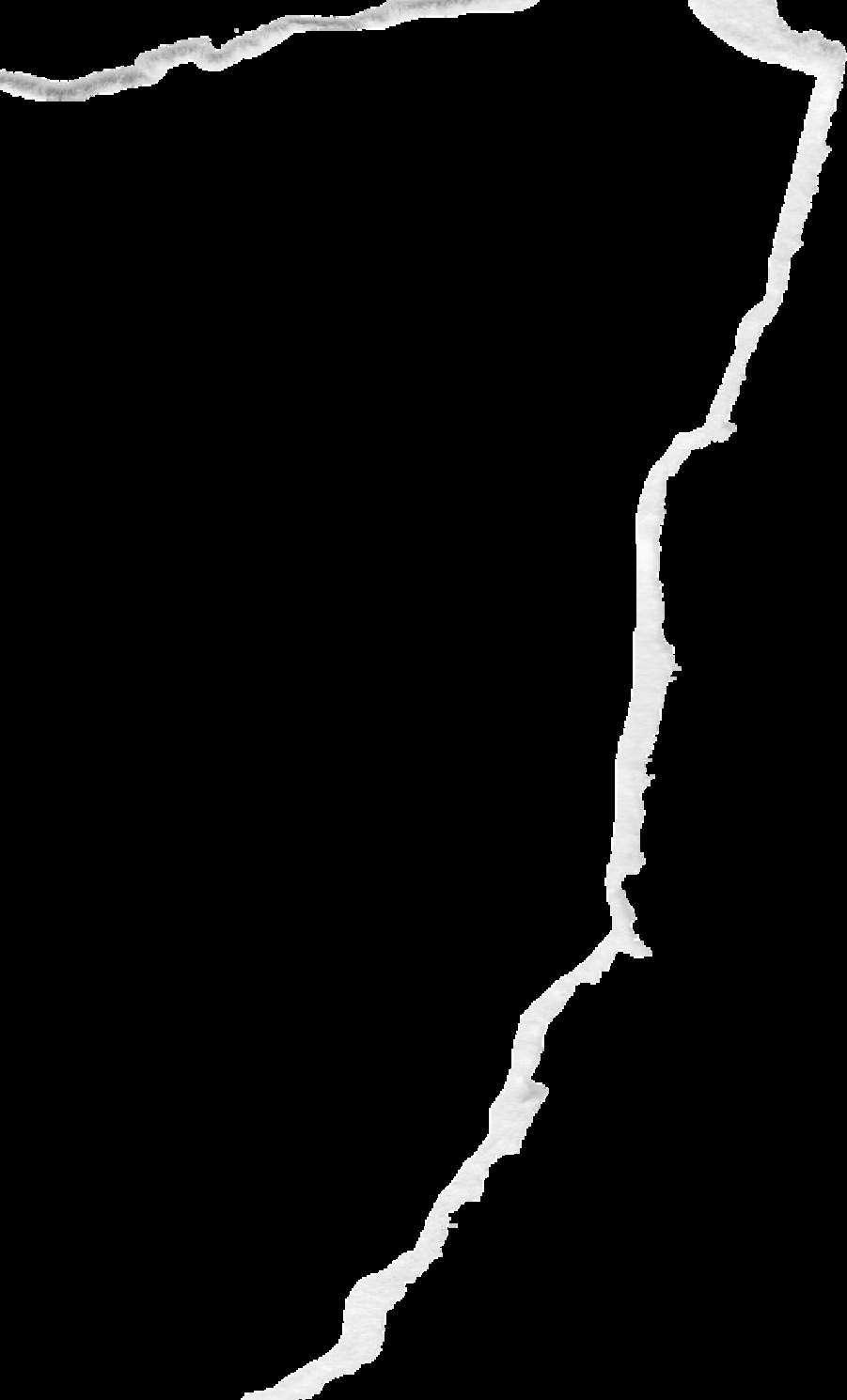
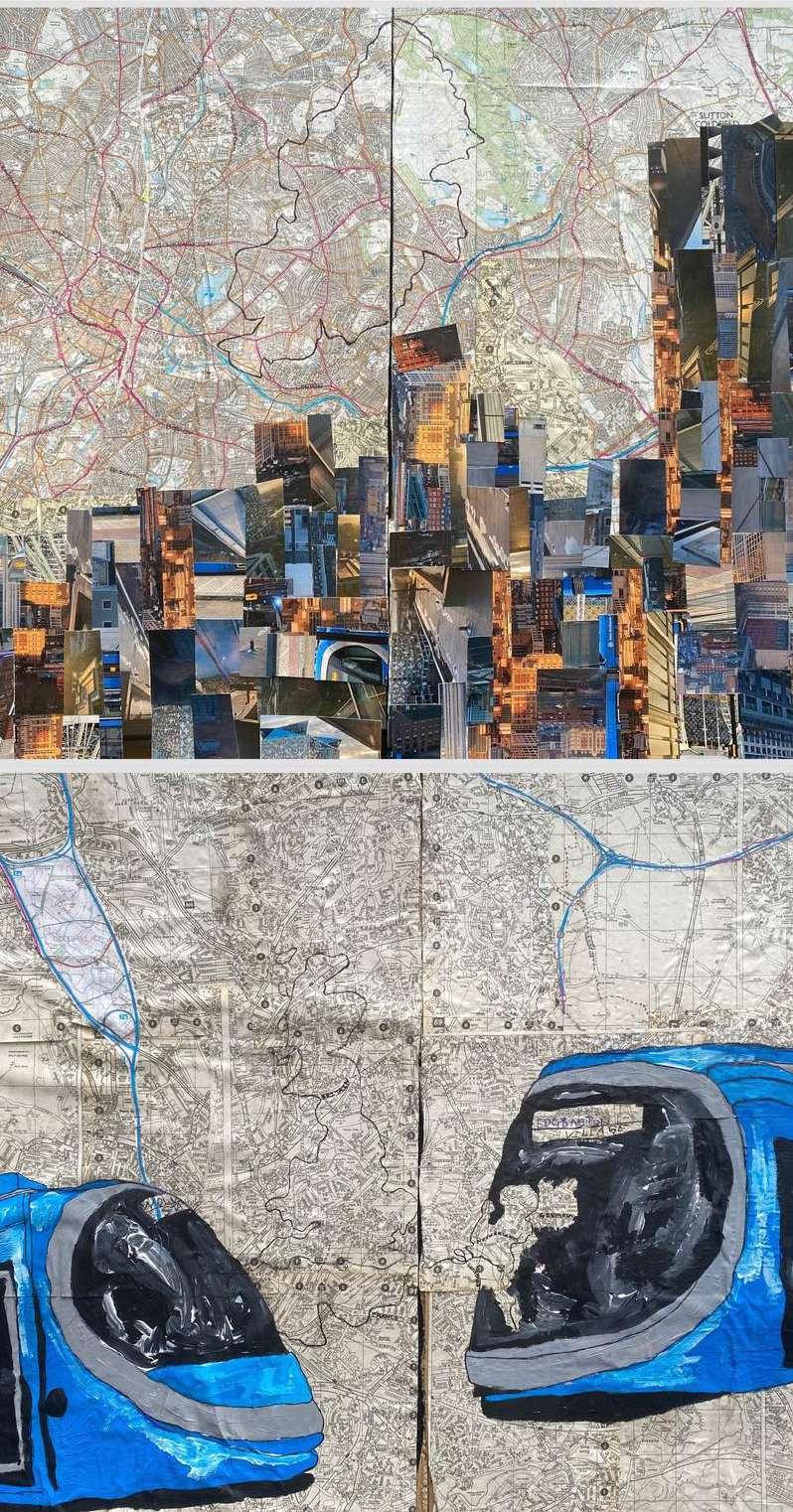

Willem van Genk (1927–2005) was a Dutch artist known for densely detailed cityscapes informed by his fascination with transportation and travel.
Van Genk’s work often looked to reflect the post-war urban environments of Europe, including Eastern Block cities –reflecting van Genk’s admiration for Soviet order, for which he admired its political social philosophy of a citizen’s equality which he did not feel in the society he lived in.
Almost entirely self-taught and discouraged from artistic training, he was later enrolled informally at the Royal Academy. His artworks synthesised as symbols of control and escape, reflecting the artist’s struggle with his mental wellbeing, personal life and trouble being taken seriously as an artist due to being labelled as an ‘Outsider’ artist.
In his later years he achieved recognition through solo exhibitions, being the world’s most expensive ‘Outsider’ artist by the time of his death.

‘Maps and Minds: A Journey with Willem van Genk’ is curated by eight artists from Outside In. Our group came together on a Step Up Exploring Collections and Curating Exhibitions course to learn about van Genk, with most of us being unaware of his work beforehand. Each artist selected an artwork of van Genk’s that spoke to them and created work in response.
Our creative responses vary in approach and mediums, covering many themes including the urban environment, personal journeys and conflicting feelings between finding solace in the outside world and a fear of engaging with it. We have brought together van Genk’s work alongside our own to create an exhibition that challenges the idea of labelling of artists.
Due to the way that van Genk often repurposed old works through collage and reused surfaces, dates for some pieces cannot always be accurate. Where dates are listed on works, we have done so to the best of our knowledge with the references we have been able to find. For more information on van Genk’s life and work, you can visit the Museum van de Geest’s website that hosts the Willem van Genk Foundation information.

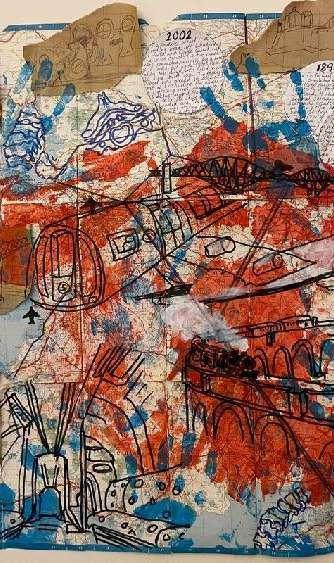

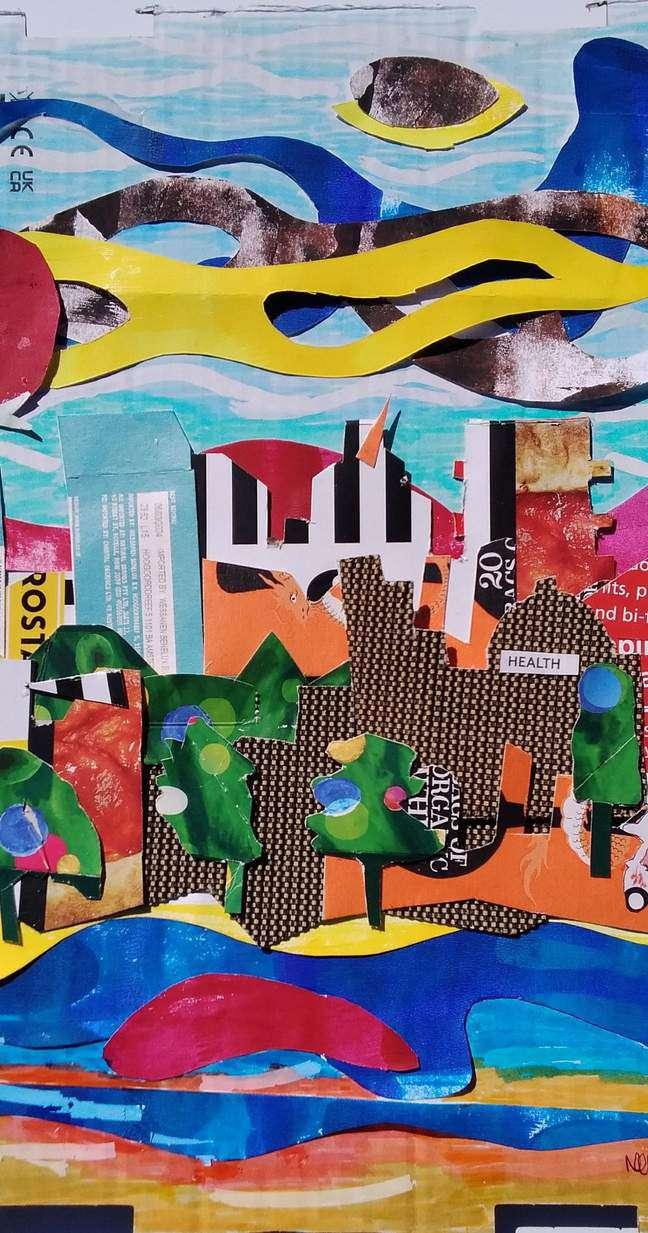

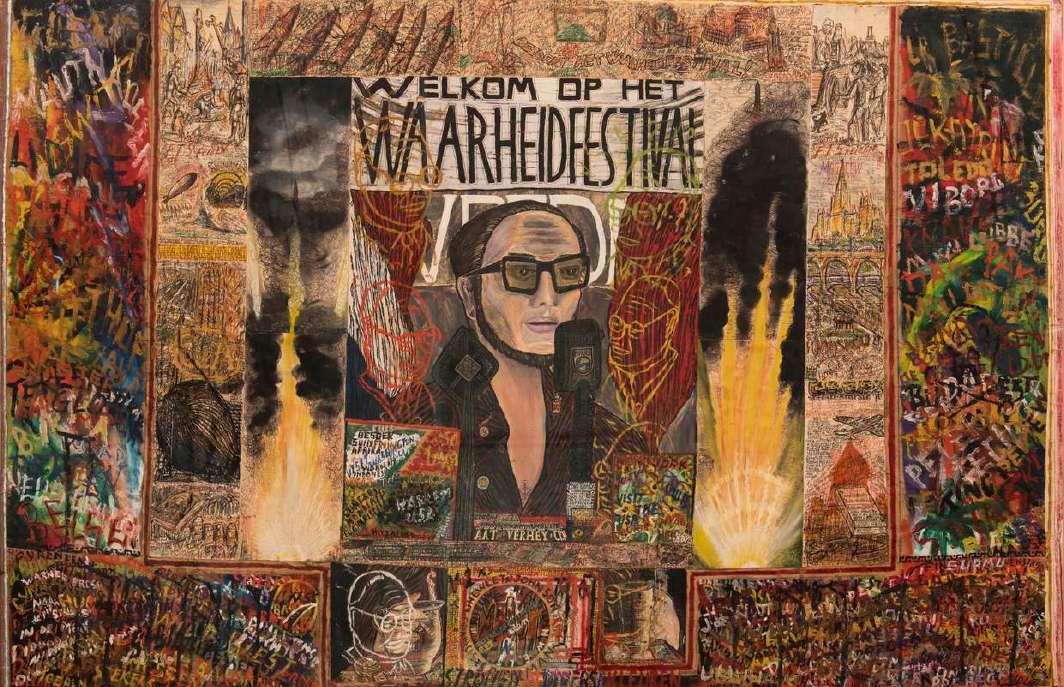
Mixed Media on Paper, 1965 – 1970
Image: Courtesy of Stichting Willem van Genk W i l l e m v a n G e n k
‘Truth Festival’ is a complex and vibrant work that embodies Willem van Genk’s intense desire to document and find order in his environment. This chaotic composition combines elements of collage, paint, and ink, incorporating fragments from newspapers, political imagery, maps, and architectural features to create a rich tapestry of power, propaganda, and personal reflection.

At the centre of the piece stands a dominant figure – likely a self-portrait of van Genk – positioned behind two microphones and enveloped in a whirlwind of text and imagery.
Trams and transit networks cut through the artwork, weaving together a sense of rigid structure with frenzied disorder. Sharp orange lines frame various sections, suggesting hidden meanings, while frantic ballpoint pen scrawls and graffiti-like strokes amplify the visual noise. Rockets pierce the composition, serving as symbols of war, belief, or unresolved conflicts. The work also presents a clash of ideologies. British priest Hewlett Johnson is depicted with a sickle and hammer, while American cardinal Francis Spellman is associated with a swastika, reflecting the tensions of the Cold War.
Van Genk’s personal struggles are revealed through references to his former agent, Pieter Brattinga, raising questions about loyalty and artistic validation. Layering is crucial in this piece –elements are rewritten, concealed, or expanded, mirroring van Genk’s refusal to allow the composition to settle. The artwork, much like the recurring Truth Festival, transcends completion and calls for active engagement. It confronts the viewer while inviting reflection on their balance between order and chaos, as well as control and surrender.

Willem van Genk’s "Truth Festival" collides truth, control, and unseen forces. His obsession with trams, transit lines, and travel served as both a guiding system and an escape. For van Genk, infrastructure propelled his journey; for me, art and spirituality light my path.
My mixed-media work, "Moral Compass", maps my journey from birth through abuse, broken family dynamics, and betrayal to an ongoing search for truth. I weave these themes together both literally and metaphorically using layers of collage, copper thread, and synthetic hair stitched into sections. Sewing became meditative as I traced experiences and movements that shaped my identity. Throughout the piece, favourite words and phrases from my group are featured. Do we overlook the smallest details, or do they harbour meanings waiting to be discovered? Like van Genk’s intricate layers, my work insists that truth is paramount.
This piece is deeply personal. At age four, my mother gave me my stepfather’s name while my birth name remained unchanged. It was my babysitter who revealed that the man I believed to be my father was my stepfather and that my siblings were my half-siblings. At fifteen, I was legally adopted by my stepfather; at seventeen, I met my biological father. These revelations inspired references to my DNA and the quote, “I can manage the truth; it’s the lies that kill me.”
The background shows detailed maps of places visited outside the U.K. and locations where I lived, inviting viewers to reflect on forces shaping their paths.

Mixed Media on Cardboard, 2024 – 2025
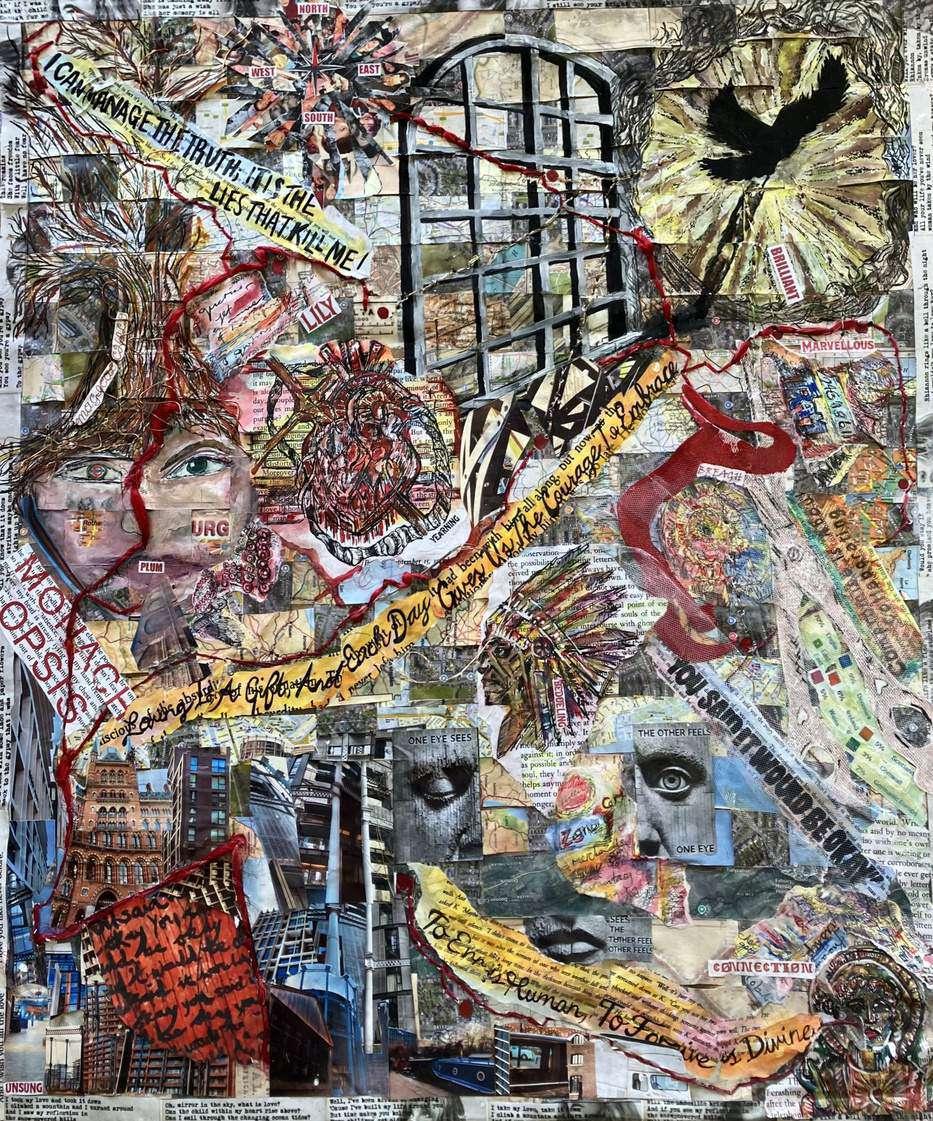
C a r l a C a n n o n
W i l l e m v a n G e n k
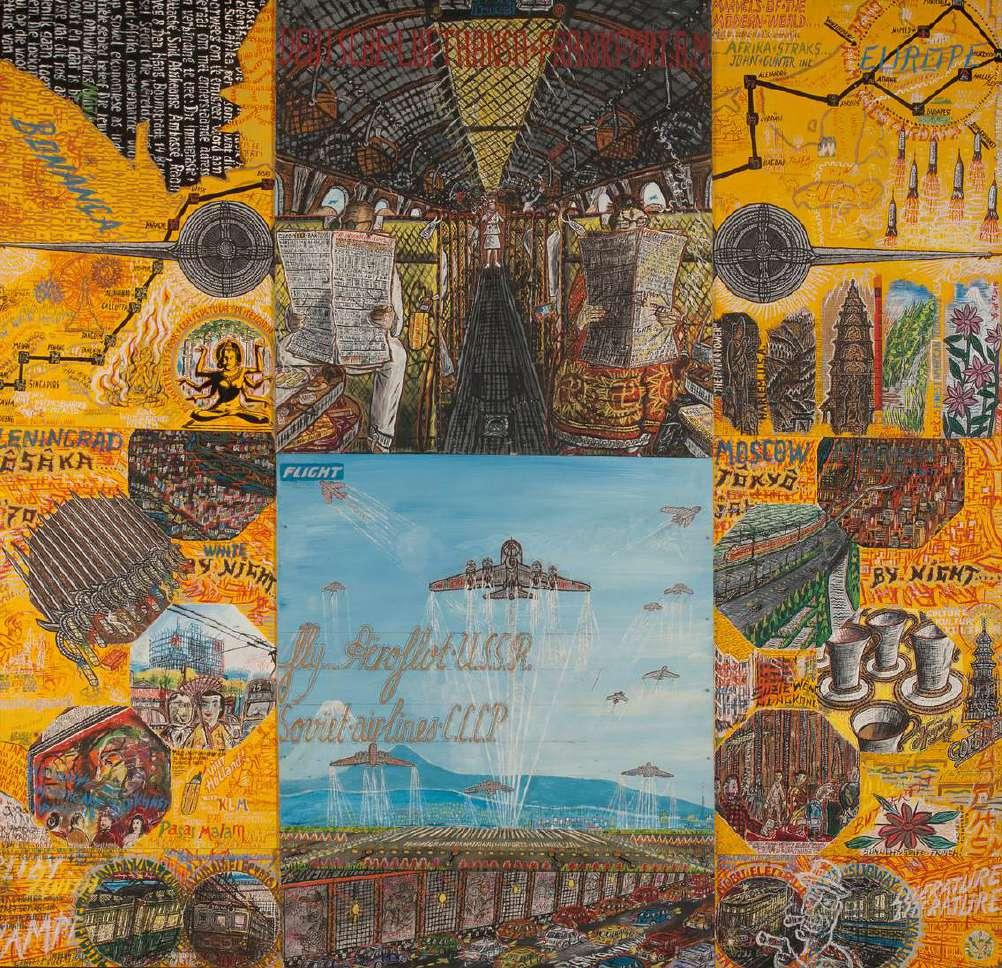

Mixed Media, 1965– 1970

Willem van Genk, a keen traveller and enjoyer of the varied types of transport available, held his fixations. From trolley buses to trams, from trains to planes, his obsession with man-made technology and their stark contrast within their urban landscapes became apparent in his series of Airport related works.
World Airport, completed in 1965 is a collection of incredibly detailed, analytical drawing of internal and external views of aircraft and the beautiful places of promise and hope, where he had been fortunate enough to travel to. Each tondo (shape) of words and image is collaged on in layers of colour, text and detail, atop a giant map of Europe where van Genk has drawn his travel routes from his native Netherlands. The work is covered in text of different fronts and colours, all hand painted by van Genk. These texts include instructions on how to source information regarding emigration to South African (top left hand corner) and many place names he had passed through or over as part of his journeys.
Van Genk has reflected map colour schemes in his use of oranges and the perhaps topographic detail in the main image, that of an internal view of an aeroplane fuselage.

Taking the key elements of what interested van Genk, I decided to create a work that endeavours to follow a journey by various types of transport, across the mainland of Scotland. In doing so, I imagined what elements of historical and engineering value to which van Genk would have been attracted e.g. The infamous Forth Rail Bridge and the Falkirk Wheel. Each added alongside tondos of information that I felt was noteworthy, as van Genk would likely have enjoyed.
Mirroring his process, I layered hand drawn images and text across a map of Southern Scotland, utilising the orange and blue colour scheme of a map and created marks using handprints and sporadic screen-printing techniques to add a sense of identity. To add to this, I incorporated elements that tie in with my own health, to reflect consideration when travelling, indicating the free travel passes issues to those under 22, over 60 and who have disabilities and reside in Scotland. I feel strongly that the travel pass makes my country accessible by all, something I imagine van Genk would have happily enjoyed taking advantage of.

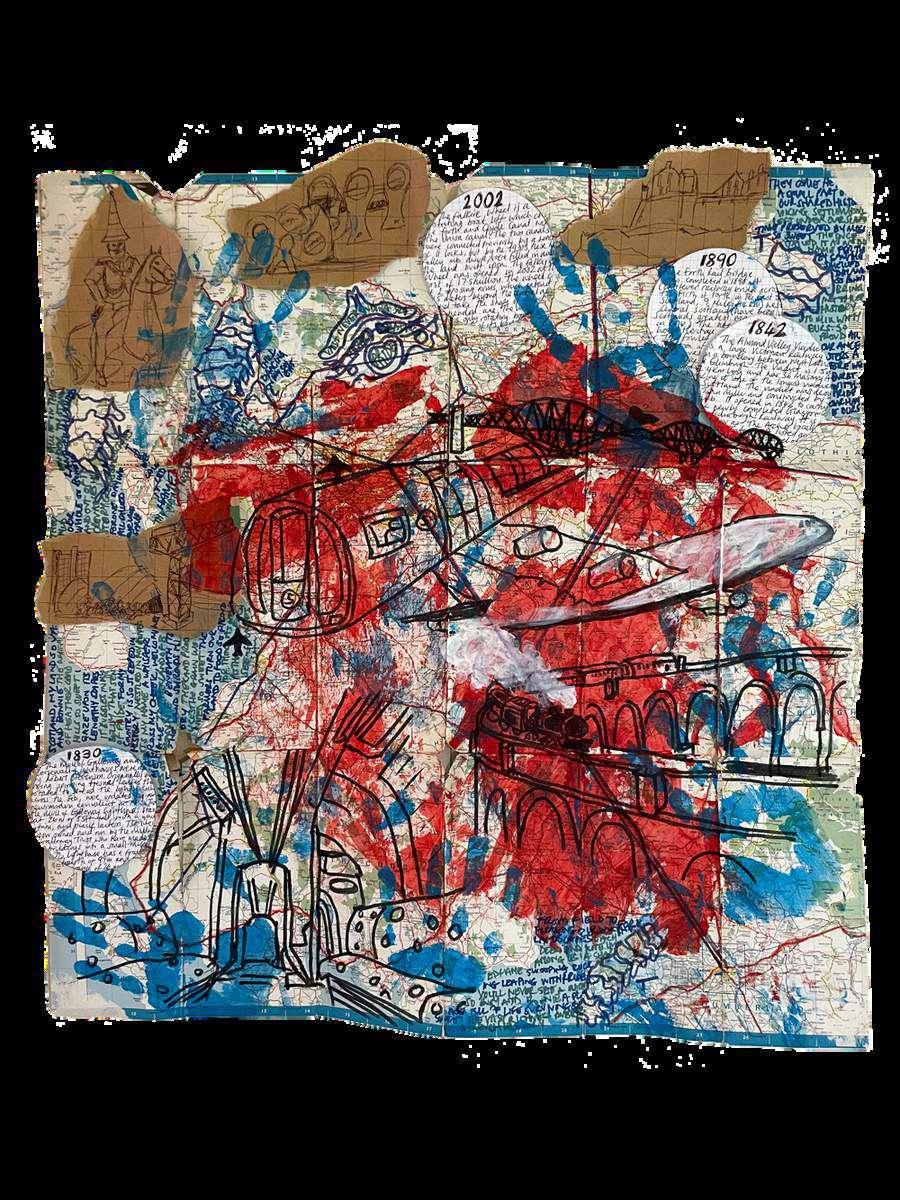
D i a n a H a m i l t o n

i l l e m v a n G e n k

Mixed Media
Metrostation Moskou is a mixed media piece by Dutch artist Willem van Genk. It translates in English to “Moscow Subway Station” depicting tram/trolleybuses in an ‘Amour Infiniti’ (French meaning: endless love) painting style, of a seemingly overcrowded subway station.
Image: Courtesy of Stichting Willem van Genk

Men and women alike working in uniforms and passersby feel less like strangers in this complex artwork. Where even the energy of children, shops, and flashing lights capture the scene. Screeeeching, to a halt.
You can almost imagine the shushing and swooshing of chatter from people. The smouldering smell of ‘grey’ vehicles in the air, and the pushing of voices and noises by each person past our ears. Yet it is silent. Line is not linear, when it comes to van Genk’s web-like harsh lined pictures, and neither are we. Kaleidoscope patterns flirt with our eyes overlooking the M… is for Metrostation, where an overarching golden giant “M” dominates the picture, looking down at the washing of bold hues of yellow, blue and green.
A feeling of our familiar but strange encounter of this scene. Almost claustrophobic, and out of our control, the scene decides where we look. Absorbing us into van Genk’s journey, despite the rushing of people drawn, it feels idyllic and isolated at the same time. Arches with words, in different languages, pushed away and lost in the crowd. Our fast-paced modern world, ever changing and seamlessly engaging can almost make you feel; forgotten.

METRO-people-LIFE!" is an admiration homage to Dutch artist, Willem van Genk (b.1927-2005) made entirely of collected travel tickets, from tram to train receipts (Nov 2024 -March 2025).
"METRO-people-LIFE!" is a commentary on our fast-paced technological consumerist world we live in. It is everything and nothing all at once, capturing the delight of art making.
From a fast-paced metropolis to people! People are life!
Coughing, chattering, clattering like lights in the night, blinking. A suffocating betrayal of cut and paste placement of social isolation and claustrophobia turned cities, like dough. Good thing, my hands move through a drawing and are fixed like van Genk. My mind at ease and the smell of ink on the paper receipt as I tear each one endlessly into a pulp, is familiar. We all know how to catch a bus, train or plane, but don’t question it. Yet my personal self is vibrating, a lanyard around my neck… aren't we all unique and human? Consumed by my making and drawing of each line or mark.
Orange and blues poke through the work as tiny texts show through like a ghostly image. Van Genk spent most of his life drawing/painting highly detailed trams, trains, monuments, buildings, planes, parades and people in certain settings.
Ink, biro and gouache on papier-mâché pulp of found travel receipts, 2025
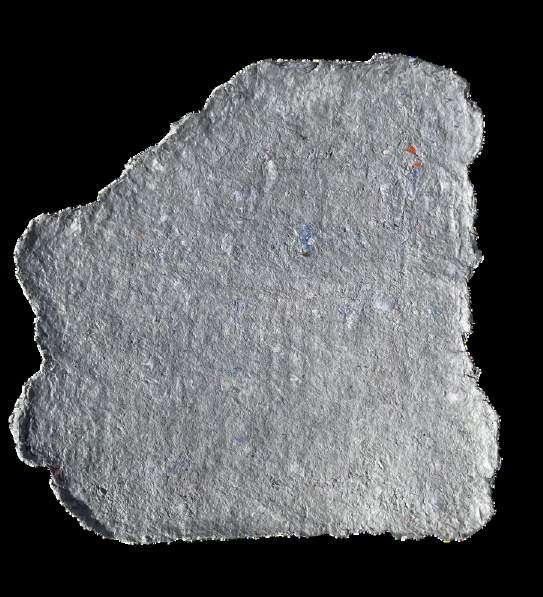
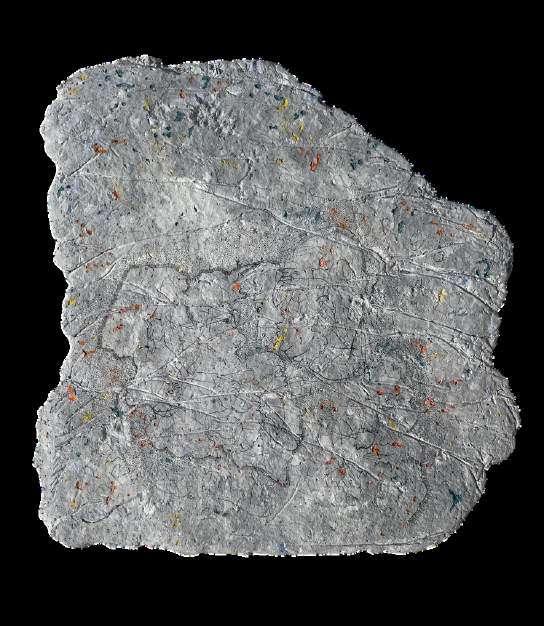
A feeling I wanted to capture in our modern times, to create reflection and a blissful silence. Questioning where and how we all fit in? That maybe we have more in common, than that sets us apart.

J a y O t t e w e l l
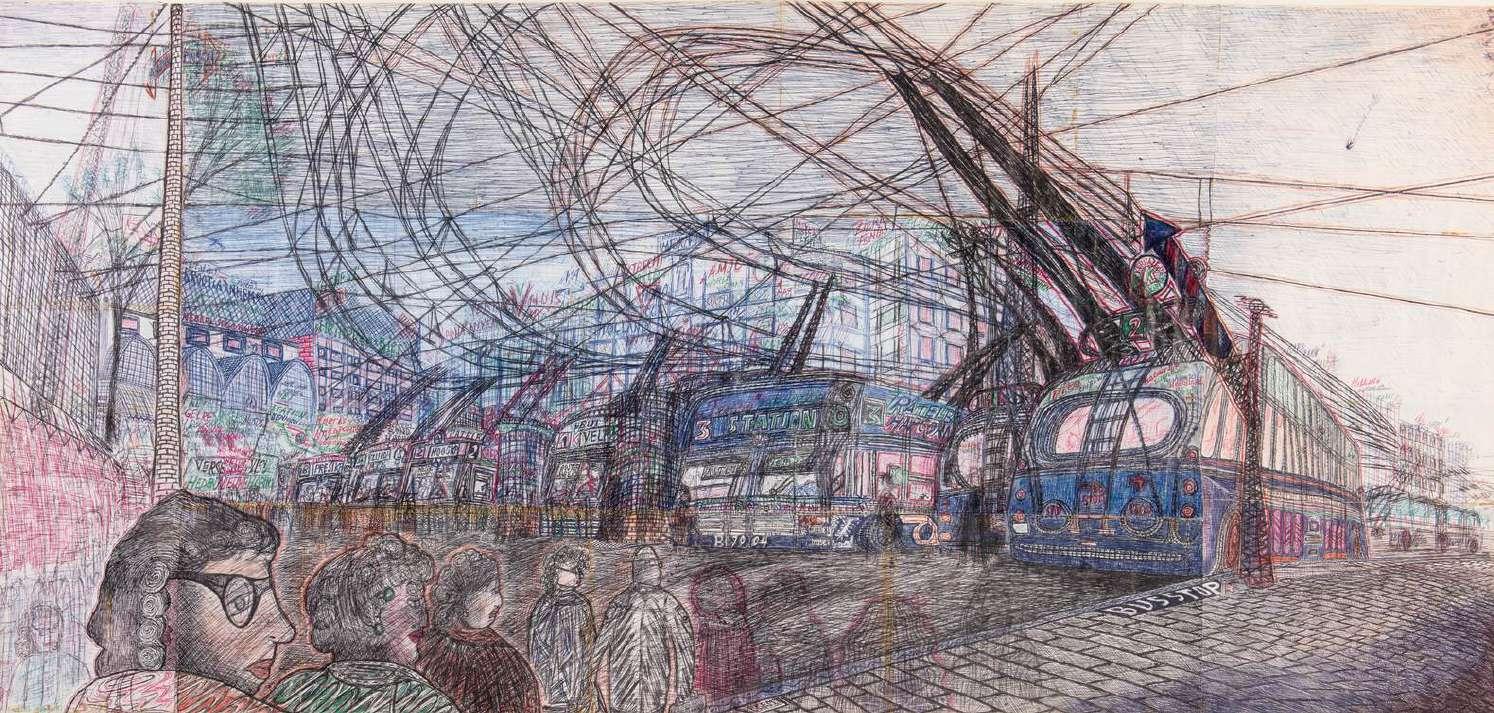
W i l l e m v a n G e n k

Ballpoint on Paper, 1996
Image: Courtesy of Stichting Willem van Genk

‘Trolleybusstation Arnhem’ is possibly the last work van Genk completed before he suffered his two cerebral infarctions. It is an enlargement and elaboration of a drawing included in the 1994 work Zagreb.
Around 1990, a final phase within van Genk's oeuvre had begun, in which he made colour copies of sections of biros drawings, enlarged them and glued them back together on another sheet of paper. After this, he processed the new result with biros and sometimes other media.
This work depicts a row of six trolleybuses with destinations such as Presikhaaf, Hoogkamp and Velp, with some passers-by in the foreground and Arnhem's train station with adjacent buildings in the background.
What is particularly striking is the strongly accentuated tangle of overhead wires, with which the front bus in particular appears to be completely fused.
Ink, packaging paper 2025
Made in response to van Genk's "Trolleybusstation Ar of a diagnosis of multiple sclerosis (MS) and first relap
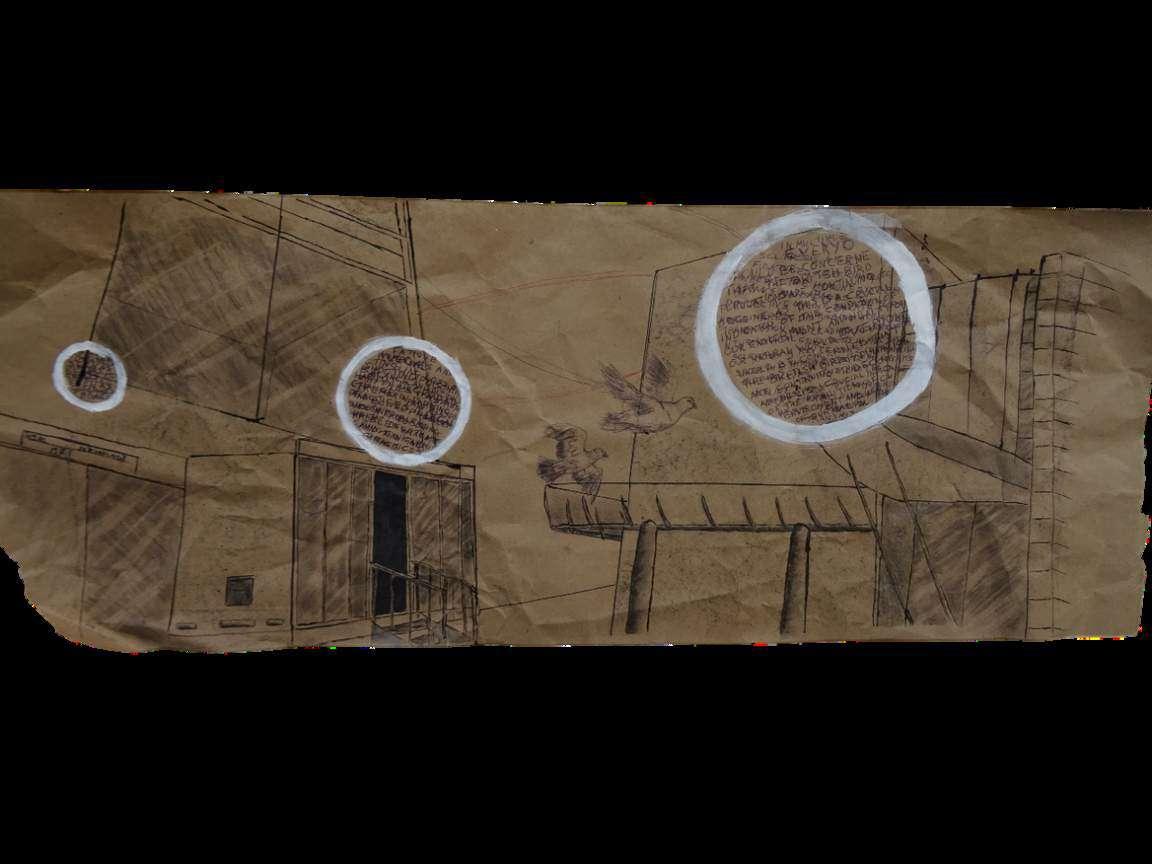
Demyelination refers to the damage where the myelin sheath surround of signals through the affected nerves, resulting in a decrease in their c lead to deficiencies in sensation, movement, cognition, or other functio managed medicinally, but it does not repair the sheath.
Temporarily paralysed, the artist reflects on finding comfort in the out The pigeons surveyed from the hospital window, the memories of an e natural world helped on the way to recovery.


ding neurons is damaged. This damage disrupts the transmission conduction ability. Consequently, this reduction in conduction can ons depending on the nerves affected. Some of these loses can be side world as well as the fear initially felt during her first relapse. xtraordinary experience with red kites and a deep love of the

W i l l e m v a n G e n k


Praag Mixed Media on Hardboard. 1963

Titled for the city that it represents, this work is created in four pieces. Dated the same year in which van Genk took an eight-day group trip to Czechoslovakia, the views show Wenceslas Square, from the roof of the National Museum, in all its glory with an equestrian statue dedicated to Wenceslas, the patron saint of Bohemia. It is 1st May, Labour Day and there is what appears to be a procession of trams. Below is a street view of Prague with the emphasis on city transport.
"Praag" establishes a connection of sorts between Czechoslovakia and Sweden; the seam of lower 2 panels depicts a map including both countries. A train journey is available to take from the Czech town of Carlsberg to Trelleborg, Sweden via Prague and Berlin. It is unknown if van Genk took this journey but it is likely that he instead studied it from a leaflet.
"Praag" is an example of van Genk’s admiration for the USSR. The city is glorified through transport and order. If not made by someone outside of the Eastern Bloc, "Praag" could even be a piece of propaganda art, promoting a way of political control which can produce and govern cities into great order. This work is dated five years before the Prague spring of 1968 which subsequently altered van Genk’s idealistic view of the USSR. The back of the work is not neglected, with collaged notes and possible souvenirs from van Genk’s trip through Czechoslovakia that year.

Getting to know the work of van Genk has allowed me to approach making work in different ways, through using different techniques and media to that of which I would normally employ and incorporating the use of a sketchbook – something that I do not do in my own practice. In the vein of van Genk’s “Praag”, I decided to make a work depicting the city I call home; Birmingham. The work is a thank you to the city, a love letter of sorts.
Working on repurposed cardboard, the background is collaged with maps of Birmingham and its surroundings on each panel whilst the upper two panels have a cityscape of Birmingham collaged using cut up photographs I took around the city. The lower two panels show Birmingham trams in the distinctive blue, painted using gouache. These panels also have a map drawn in of a route from Britain to the Netherlands.
The upper two panels also feature an outline of Birmingham’s border in pen with the names of cities I have visited written into the top left and cities that van Genk visited written into the top right panel.
Van Genk’s work often gives a sense that the artist was more content in cities, which is something I can relate to on a personal level. I like the anonymity, activity and ever evolving nature of large, dense urban environments – which is what Birmingham gives me as an adopted home. It’s often said “Brum; it’ll be good when it’s finished”.

Birmingham
Mixed Media on Cardboard, 2025
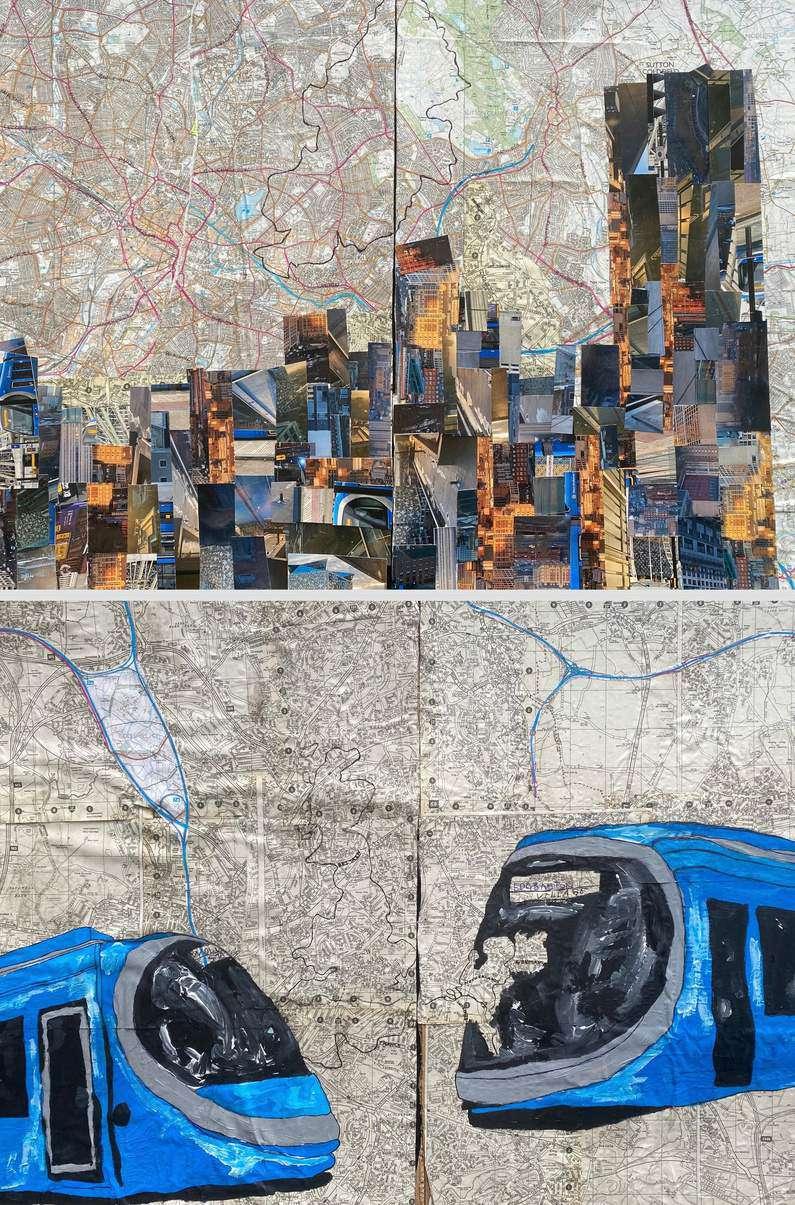

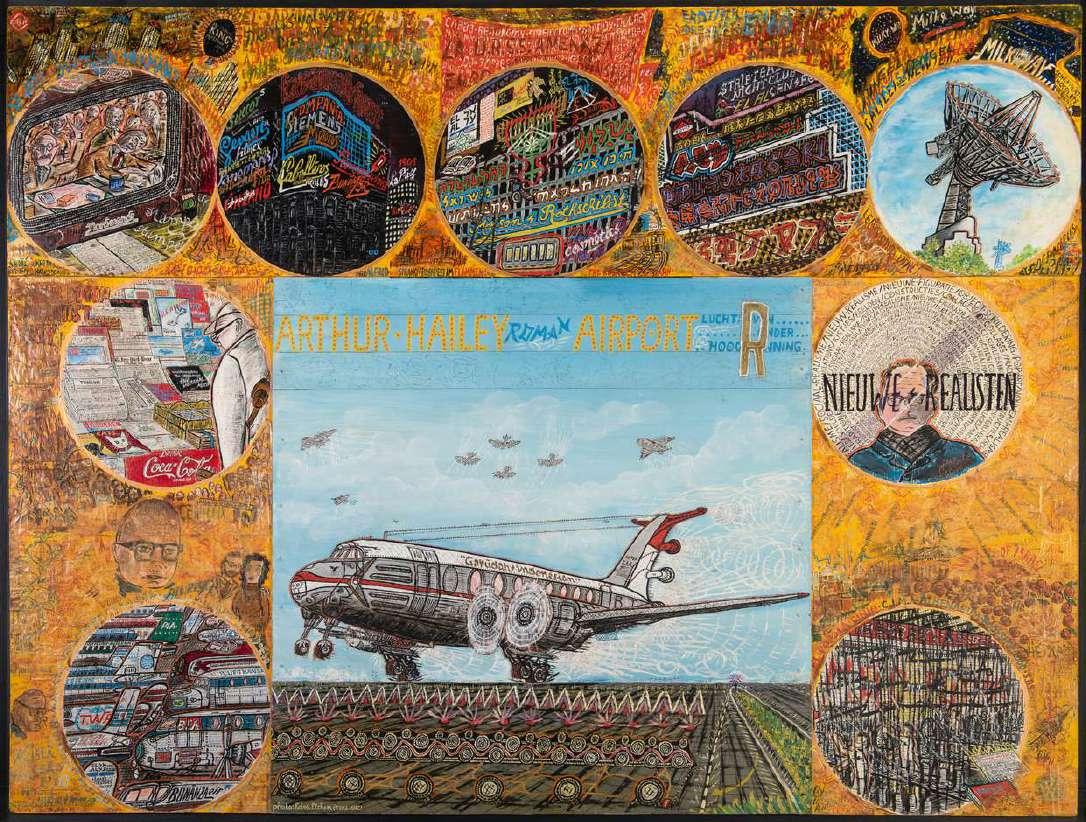
I love van Genk’s depiction of light and air. It’s almost as if he could see structures that are usually hidden in the substrates of these elements. In fact, in this and many other van Genk artworks in this exhibition, air seems to have an animistic quality.
This way of showing the aliveness in air and light relates to my interest in shamanism, which is a way of seeing everything as alive and being in relationship with it all. We can see this in the oranges and yellows of the geometric details on the runway, and the white circles and spirals around the airplane that create a sense of movement.

Van Genk liked documenting cities and travel in his art. Here we see references to Indonesia and Israel, and the tondos seem to highlight the use of advertising in city centres and on television. There are lots of words, copied from advertising, alongside situations where these words are broadcast, capturing the general busyness of capitalism at work, producing profits.
The mundane details of life in art are a tenet of the New Realism movement that van Genk acknowledges in a tondo. I wonder whether painting these scenes had an unconscious aspect to them. Was the earth speaking through him, asking us to honour the animistic forces present in the elements? I wonder how van Genk felt as he drew air and light moving. Did he feel less alone?
My art process includes shamanic practices, such as drumming to go into trance states to connect with the land and ancestors. I drummed to the spirit of van Genk and I felt a deep loneliness – cold, dark, and a fear within that. That night I couldn’t sleep and began to make a 3D shape from chicken wire.
Memories of a time when I felt a deep loneliness emerged and the title "Black Hole of Loneliness" repeated in my head as the sculpture formed. Van Genk didn’t have access to people who treated him as a person, an equal human being. As a person his power was often taken away by others judging him as mentally not okay, but his power as an artist is there for all to see in the amazing details and animation of natural forces in his work.
For this piece I was drawn intuitively to use chicken wire, attach pipe cleaners, and papier maché over the chicken wire. Although, like van Genk, I love repetition, I usually choose to paint dots on canvas. By experimenting with these materials, I’ve made something that feels very alive – loneliness animated.
One of the basic truths in shamanism is that everything is alive and demands feeding. Often, we unconsciously feed things we don’t want. I’m wondering about the unconscious ways I feed loneliness and what I might like to consciously feed.

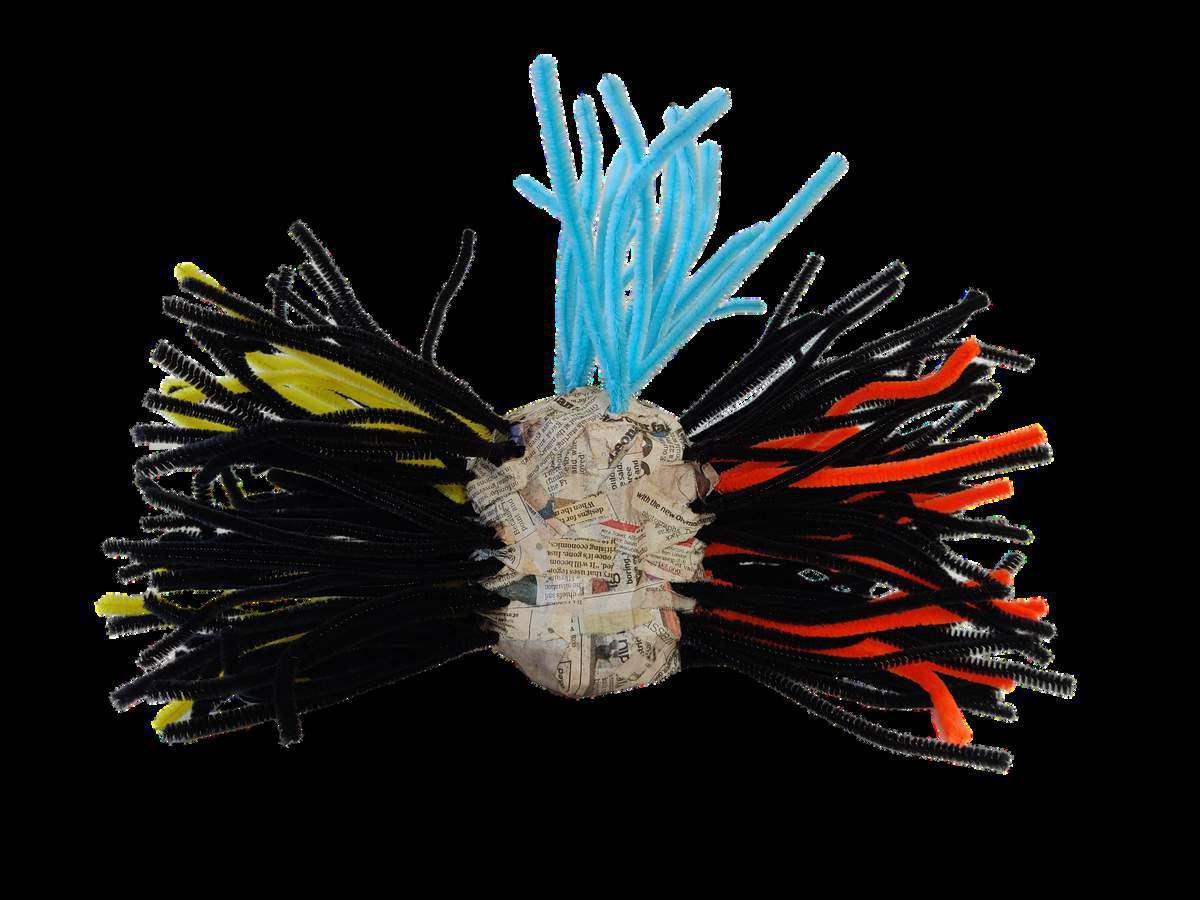
Chicken wire, papier mache, and pipe cleaners, 2025


i l l e m v a n G e n k
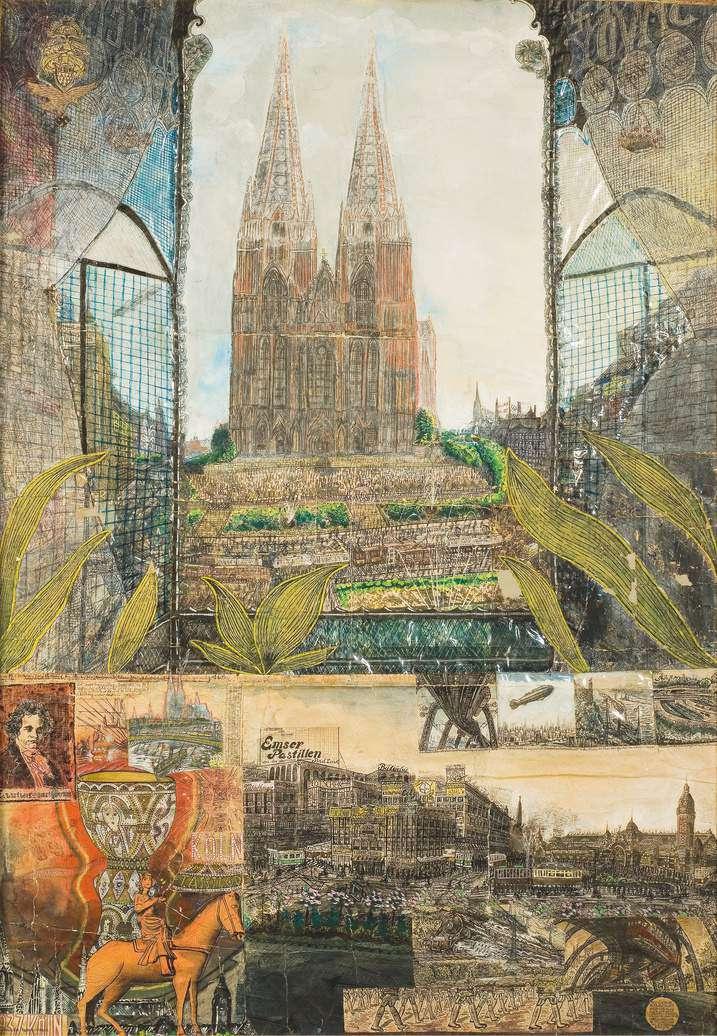

Oil Paint on Hardboard, 1960
Image: Courtesy of Stichting Willem van Genk

This painting has a spiritual focus. Its intricate beauty transports you to an other-worldly scene. Van Genk paints an open window with flowing curtains which opens onto the view of an elevated cathedral.
The cathedral becomes the focal point, as if symbolic of a spiritual destiny which the artist fulfils in the making of this piece. The final destination is peace of mind, as both artist and viewer are transported to a world where the mind floats free. The colours are vibrant, modern and colourfully contrasting.
Van Genk developed his pictures, paintings and collages over time and builds his imagination in layers. Here they culminate in a heavenly apparition of spires, gardens, architecture and lush vegetation; aspiring, transcending you to other worlds beyond this earthly realm.
Beneath the spire, van Genk constructs a fiery netherworld, of contrasting imagery.

Van Genk had serious mental health issues, but was also extremely creative and relied on his art as a means to get by. I identify with him on that level.
A person ' s creativity can be something that is continuous in their life. Jobs, relationships and friendships sometimes aren't.
Van Genk’s prolific creative output carved him a life where friendships had failed him and I feel a kinship with that.
When setting out to produce a visual response to van Genk’s work I tried to put myself in his shoes. I believe he was extremely talented and I view him to be a unique and wonderful artist.
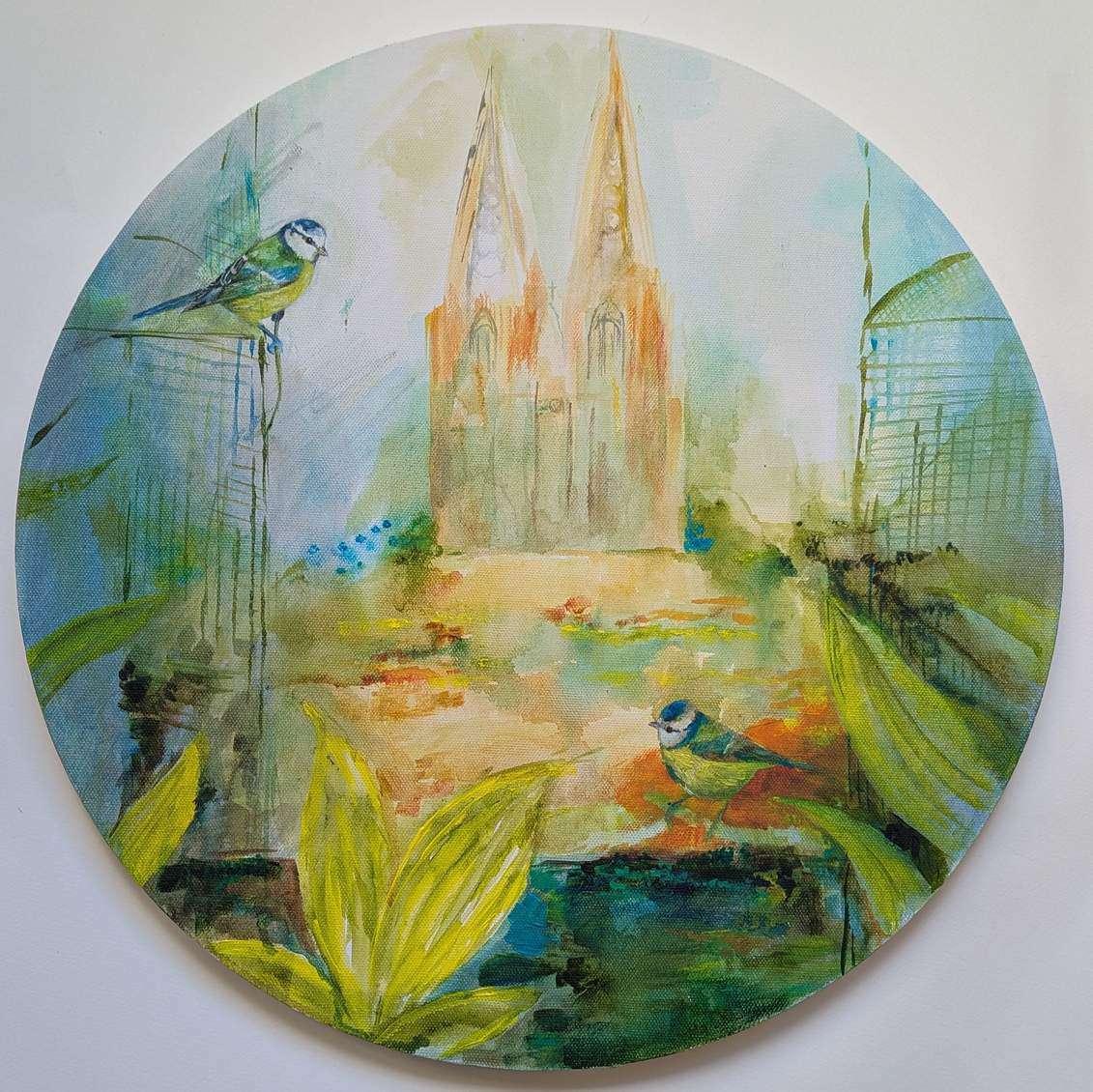

K a t e B r a d l e y

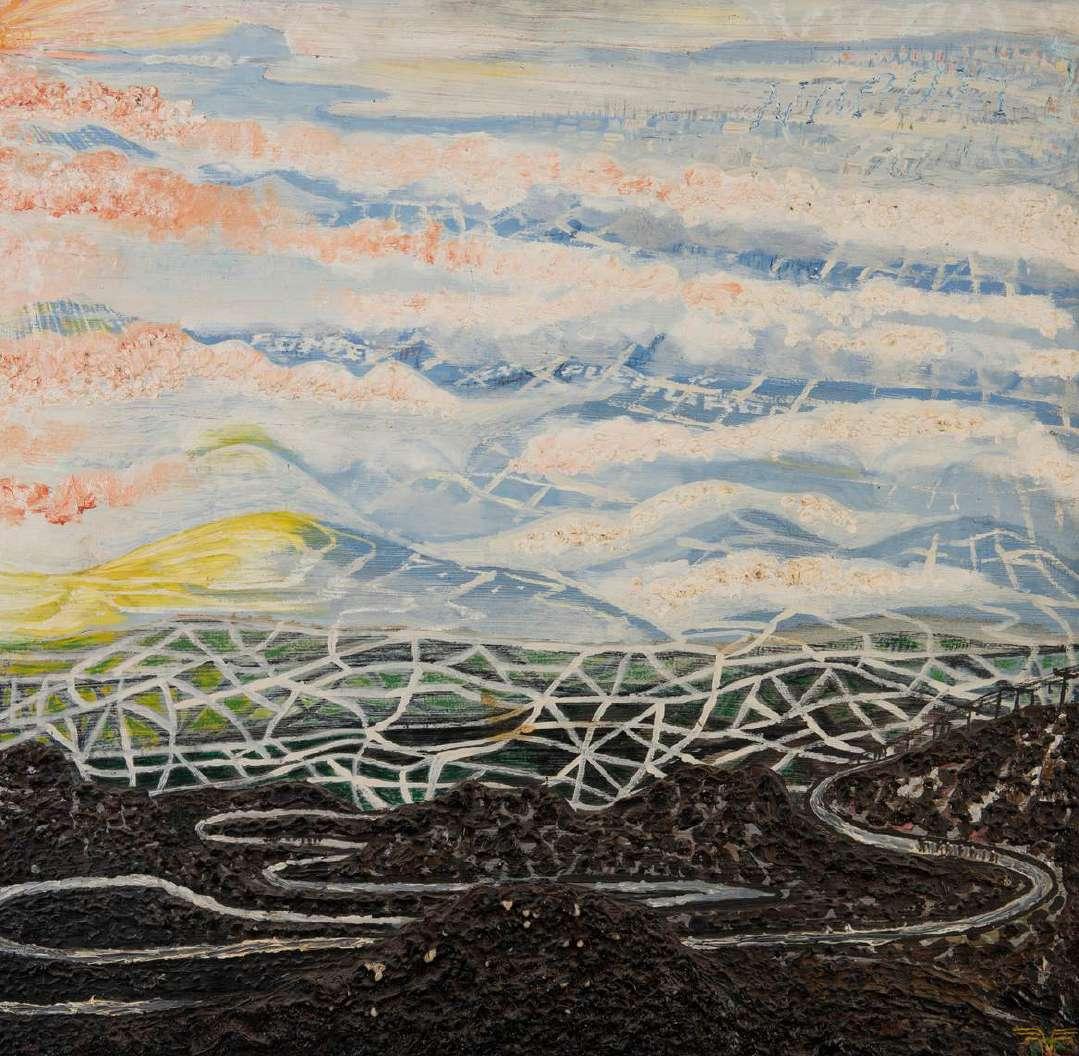
i l l e m v a n G e n k Image: Courtesy of Stichting Willem van Genk
Oil Paint on Hardboard, Date Unknown

It is unknown if van Genk visited Mount Vesuvius prior to painting this. Does this artwork represent a memory of a visit, or an imaginative representation of images of the Mount Vesuvius area he used as reference? Unlike most of van Genk’s other artworks, "Vesuvius" has breathing space, it is light, unhurried.
Its colour palate of pale blues, white and pinks of wispy clouds, tinged with orange partly obscure the landscape below. A radiant sunburst, its golden yellow with tinges of oranges and reds imitate a sunset. It is similar to other artworks in its aerial view, taking in a distant shoreline.
The painting overlooks the volcanic landscape but unlike his other artworks it is not populated with transport vehicles, buildings, aeroplanes, or zeppelins. The white criss-crossed ‘tracks’ have an appearance of a net or web in the mid-ground area of the painting conveying a fractured effect. The foreground employs a different technique a dark brown highly textured surface mimicking the violent volcanic earth, pitted, spiky and threatening with tiny figures.
The back of this painting is intriguing with various magazine images, postcards, hotel details stuck on with words ‘Vesuvius’, ‘Expo’, ‘58’, ‘Brussel’ and ‘universal’ inscribed with various statements of intent to visit, Rome, Naples, Milan, Florence, Venice and Monte Carlo. In 1958 there was World Expo ‘58 which was held in Brussels, Belgium.

This artwork is in response to Willem van Genk’s artwork 'Vesuvius'. Willem van Genk represented the cityscape in many of his artworks. I wanted to represent my view of the cityscape but to give the city a lighter and energic atmosphere. The repurposed packaging and painted cut out shapes represent buildings, trees, sky, clouds, water all combined to make a layered condensed cityscape. This was an experimental piece, to convey the atmosphere of a city, its busyness, juxtapositions of buildings, texture and context, spaces and heights. I used natural representations of trees, clouds, water and celestial bodies in contrast to manmade elements. The watery surface reflects the banks of the River Trent, Nottingham where I live. The colour palate used is primarily primary colours, I also incorporated oranges and browns as used by van Genk.
By repurposing packaging materials, it mirrors consumerism and advertising in the landscape of modern life and urban living, but also reflecting the richness, variety and beauty of the environment and the many ‘voices’ it resonates and compliments. The figure of a food delivery person reflects the obligatory presence around many urban town centres. In homage to van Genk a solitary passage plane transverses a moody sky. The use of materials, magazine images, reused packaging, and corrugated cardboard reflect society’s throwaway mindset, it also reflects van Genk’s use of cardboard, magazines images, postcards and comic strips in his artworks.



Cantey, J. Art Term Tuesday: Horror Vacui, From the Fort Wayne Museum of Art. Available at https://fwmoa.blog/2018/06/26/art-term-tuesday-horrorvacui/ accessed on 29/11/24
Di Marzo, C. Nico van der Endt interview: ‘Willem van Genk was a visionary, a man discovering a universal truth about the human species’ , Studio International. Available at https://www.studiointernational.com/willem-van-genkmind-traffic-american-folk-art-museum-nico-van-derendt accessed on 29/11/24 Praag. Museum van de Geest. Available at https://museumvandegeest.nl/kunstwerken/praag/ accessed on 12/12/24
Ten Berje, J. ‘Confusingly Unique’: A Labelling History of Willem van Genk. The Rijks Museum Bulletin.
Waarheidfestival: Willem van Genk, Museum van de Geest. Available at https://museumvandegeest.nl/kunstwerken/waarheidfestival / accessed on 22/11/24
Van der Endt, N. Willem van Genk Chronicle. (Partial version.) Available at https://issuu.com/lecturis/docs/willem_van_genk_issuu accessed on 08/12/24
Van der Weide, J. Willem van Genk: The Unity of the Spider’s Web (Biography of an Unprecedented Genius). Raw Vision.

Van der Weide, J. Zondagsschilder. 2nd December 2019.
Het Wereldwijde Web van Willem van Genk. Available at https://willemvangenk.net/2019/12/02/zondagsschilder/ accessed on 22/01/25
Van der Weide, J. Pilsen. 2nd December 2019. Het
Wereldwijde Web van Willem van Genk. Available at https://willemvangenk.net/2019/11/13/pilsen/ accessed on 22/01/25

Van Os, J. The Labels of Willem van Genk. Museum Van de Geest.
Available at https://museumvandegeestnl.translate.goog/verhalen/de-labels-van-willem-van-genk/?
_ x _ tr _ sl=auto& _ x _ tr _ tl=en& _ x _ tr _ hl=enUS& _ x _ tr_pto=wapp&_x_tr_hist=true accessed on 12/12/24
Victoria Art Gallery. How to Curate an Exhibition
Available at: https://www.youtube.com/@victoriaartgallerybath accessed on 19/01/25
Virtual Tour, Bethlem Museum of the Mind. Available at https://my.matterport.com/show/?m=z5sTwMgyHS3 accessed on 12/12/24
We Are The Museum of the Mind! Museum van de Geest.
Available at https://www.youtube.com/watch?v=AMPsinBoV_U accessed on 12/12/24
Willem van Genk: Collage of Hate, Raw Vision. Available at https://rawvision.com/blogs/articles/articles-collage-hate?
srsltid=AfmBOoqDo1_cf5PWonQgKzEN4nmKqXXKIycxKhNPM3lcJ2 4O7MpmGqCA accessed on 29/11/24
Willem van Genk – Megalopolis- March 4 Through June 27, 2021, Collection D’lart Brut Lausanne. Available at https://www.artbrut.ch/en_GB/exhibition/willem-van-genk accessed on 29/11/24

Willem van Genk: Mind Traffic, American Folk Art Museum.Available at https://folkartmuseum.org/exhibitions/willem-van-genk-mindtraffic/ accessed on 22/11/24
Willem van Genk – Woest, Kunstblijfteenraadsel. Available at https://kunstblijfteenraadsel.nl/2020/01/12/willem-van-genkwoest/ accessed on 22/11/24
Wojcik, Daniel. “Outsider Art, Vernacular Traditions, Trauma, and Creativity. ” Western Folklore, vol. 67, no. 2/3, 2008, pp. 179–98. JSTOR, http://www.jstor.org/stable/25474913. Accessed 5 Feb. 2025.
You can view the exhibition ‘Maps and Minds: A Journey with Willem van Genk’ on Outside In’s website here.
A huge thanks to our funders, Baring Foundation and a private donor and to the Museum van de Geest for providing access to the Willem van Genk Foundation’s collection.


